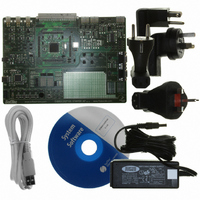EVB9S12XEP100 Freescale Semiconductor, EVB9S12XEP100 Datasheet - Page 603

EVB9S12XEP100
Manufacturer Part Number
EVB9S12XEP100
Description
BOARD EVAL FOR MC9S12XEP100
Manufacturer
Freescale Semiconductor
Type
MCUr
Datasheet
1.EVB9S12XEP100.pdf
(1328 pages)
Specifications of EVB9S12XEP100
Contents
Module and Misc Hardware
Processor To Be Evaluated
MC9S12XEP100
Data Bus Width
16 bit
Interface Type
RS-232
Silicon Manufacturer
Freescale
Core Architecture
S12
Core Sub-architecture
S12
Silicon Core Number
MC9S12
Silicon Family Name
S12XE
Rohs Compliant
Yes
For Use With/related Products
MC9S12XEP100
Lead Free Status / RoHS Status
Lead free / RoHS Compliant
- Current page: 603 of 1328
- Download datasheet (9Mb)
before reading the 2nd last byte of data. Before reading the last byte of data, a STOP signal must be
generated first. The following is an example showing how a STOP signal is generated by a master receiver.
15.7.1.5
At the end of data transfer, if the master continues to want to communicate on the bus, it can generate
another START signal followed by another slave address without first generating a STOP signal. A
program example is as shown.
15.7.1.6
In the slave interrupt service routine, the module addressed as slave bit (IAAS) should be tested to check
if a calling of its own address has just been received. If IAAS is set, software should set the transmit/receive
mode select bit (Tx/Rx bit of IBCR) according to the R/W command bit (SRW). Writing to the IBCR
clears the IAAS automatically. Note that the only time IAAS is read as set is from the interrupt at the end
of the address cycle where an address match occurred, interrupts resulting from subsequent data transfers
will have IAAS cleared. A data transfer may now be initiated by writing information to IBDR, for slave
transmits, or dummy reading from IBDR, in slave receive mode. The slave will drive SCL low in-between
byte transfers, SCL is released when the IBDR is accessed in the required mode.
In slave transmitter routine, the received acknowledge bit (RXAK) must be tested before transmitting the
next byte of data. Setting RXAK means an 'end of data' signal from the master receiver, after which it must
be switched from transmitter mode to receiver mode by software. A dummy read then releases the SCL
line so that the master can generate a STOP signal.
15.7.1.7
If several masters try to engage the bus simultaneously, only one master wins and the others lose
arbitration. The devices which lost arbitration are immediately switched to slave receive mode by the
hardware. Their data output to the SDA line is stopped, but SCL continues to be generated until the end of
the byte during which arbitration was lost. An interrupt occurs at the falling edge of the ninth clock of this
transfer with IBAL=1 and MS/SL=0. If one master attempts to start transmission while the bus is being
engaged by another master, the hardware will inhibit the transmission; switch the MS/SL bit from 1 to 0
without generating STOP condition; generate an interrupt to CPU and set the IBAL to indicate that the
Freescale Semiconductor
MASR
LAMAR
ENMASR
NXMAR
RESTART
Because of an order from the United States International Trade Commission, BGA-packaged product lines and partnumbers
indicated here currently are not available from Freescale for import or sale in the United States prior to September 2010
DEC
BEQ
MOVB
DEC
BNE
BSET
BRA
BCLR
MOVB
RTI
BSET
MOVB
Generation of Repeated START
Slave Mode
Arbitration Lost
RXCNT
ENMASR
RXCNT,D1
D1
NXMAR
IBCR,#$08
NXMAR
IBCR,#$20
IBDR,RXBUF
IBCR,#$04
CALLING,IBDR
MC9S12XE-Family Reference Manual Rev. 1.23
;DECREASE THE RXCNT
;LAST BYTE TO BE READ
;CHECK SECOND LAST BYTE
;TO BE READ
;NOT LAST OR SECOND LAST
;SECOND LAST, DISABLE ACK
;TRANSMITTING
;LAST ONE, GENERATE ‘STOP’ SIGNAL
;READ DATA AND STORE
;ANOTHER START (RESTART)
;TRANSMIT THE CALLING ADDRESS;D0=R/W
Chapter 15 Inter-Integrated Circuit (IICV3) Block Description
603
Related parts for EVB9S12XEP100
Image
Part Number
Description
Manufacturer
Datasheet
Request
R
Part Number:
Description:
Manufacturer:
Freescale Semiconductor, Inc
Datasheet:
Part Number:
Description:
Manufacturer:
Freescale Semiconductor, Inc
Datasheet:
Part Number:
Description:
Manufacturer:
Freescale Semiconductor, Inc
Datasheet:
Part Number:
Description:
Manufacturer:
Freescale Semiconductor, Inc
Datasheet:
Part Number:
Description:
Manufacturer:
Freescale Semiconductor, Inc
Datasheet:
Part Number:
Description:
Manufacturer:
Freescale Semiconductor, Inc
Datasheet:
Part Number:
Description:
Manufacturer:
Freescale Semiconductor, Inc
Datasheet:
Part Number:
Description:
Manufacturer:
Freescale Semiconductor, Inc
Datasheet:
Part Number:
Description:
Manufacturer:
Freescale Semiconductor, Inc
Datasheet:
Part Number:
Description:
Manufacturer:
Freescale Semiconductor, Inc
Datasheet:
Part Number:
Description:
Manufacturer:
Freescale Semiconductor, Inc
Datasheet:
Part Number:
Description:
Manufacturer:
Freescale Semiconductor, Inc
Datasheet:
Part Number:
Description:
Manufacturer:
Freescale Semiconductor, Inc
Datasheet:
Part Number:
Description:
Manufacturer:
Freescale Semiconductor, Inc
Datasheet:
Part Number:
Description:
Manufacturer:
Freescale Semiconductor, Inc
Datasheet:










